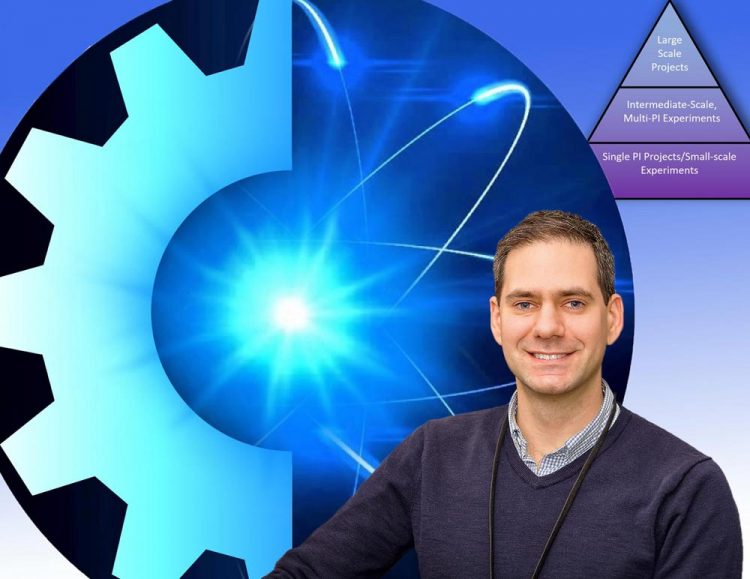A landmark plan for realizing fusion energy and advancing plasma science

PPPL physicist Nathan Ferraro with image from cover of report behind him. Credit: Photo and composite by Elle Starkman/PPPL Office of Communications.
The report, the Community Plan for Fusion Energy and Discovery Plasma Sciences, “reflects the enthusiasm among the U.S. fusion and plasma physics community to take bold steps to make fusion energy a reality, to expand our understanding of plasma physics, and to use that understanding to benefit society,” said physicist Nathan Ferraro of the U.S. Department of Energy's (DOE) Princeton Plasma Physics Laboratory (PPPL), a co-chair of the plan assembled over a year by the community.
Professional societies
The 199-page document, put together with input from hundreds of U.S. scientists and engineers from many professional societies, makes numerous recommendations, including the following proposed steps:
- In the words of the report, research going forward “should be driven by the mission to enable construction of a fusion pilot plant (FPP) that produces net electricity and thereby establishes the scientific and technological basis for commercial fusion energy.”
- Development of this mission should include immediate design of a new U.S. tokamak, or doughnut-shaped fusion facility, capable of handling conditions consistent with those that an FPP will encounter. Also immediately begun should be design and construction of a specialized device to demonstrate the effect that neutrons released by fusion reactions will have on the facility that houses the reactions.
- Advancing theory and modeling capabilities needed to understand and sustain burning plasmas, in which the plasma is chiefly heated by fusion reactions. The U.S. should also sustain full membership in ITER, the international experiment under construction in France to demonstrate the production of burning plasma.
- Scaling up research in plasma science fields ranging from astrophysics to nanotechnology. Proposed steps include construction of a general plasma science facility to study astrophysically-relevant magnetized plasma phenomena, ensuring stable funding for a balanced research portfolio, and developing networks of scientists and facilities to enable a broad range of frontier scientific research.
Designed to help fulfill a charge
The report is designed to help the Fusion Energy Sciences Advisory Committee (FESAC) fulfill a DOE charge for the development of a long-range strategy for the Fusion Energy Sciences program of the DOE Office of Science. The document calls for partnerships with other offices and governmental agencies, as well as with private industry and international partners, to enact the full recommendations of the strategic plan. “We are encouraged to see that this process brought the community together to recognize the full scope of this challenge,” said Ferraro, “and that coordinated, multi-disciplinary research and development is needed to achieve our goals.”
###
PPPL, on Princeton University's Forrestal Campus in Plainsboro, N.J., is devoted to creating new knowledge about the physics of plasmas — ultra-hot, charged gases — and to developing practical solutions for the creation of fusion energy. The Laboratory is managed by the University for the U.S. Department of Energy's Office of Science, which is the single largest supporter of basic research in the physical sciences in the United States and is working to address some of the most pressing challenges of our time. For more information, visit energy.gov/science (link is external).
Media Contact
All latest news from the category: Physics and Astronomy
This area deals with the fundamental laws and building blocks of nature and how they interact, the properties and the behavior of matter, and research into space and time and their structures.
innovations-report provides in-depth reports and articles on subjects such as astrophysics, laser technologies, nuclear, quantum, particle and solid-state physics, nanotechnologies, planetary research and findings (Mars, Venus) and developments related to the Hubble Telescope.
Newest articles

NASA: Mystery of life’s handedness deepens
The mystery of why life uses molecules with specific orientations has deepened with a NASA-funded discovery that RNA — a key molecule thought to have potentially held the instructions for…

What are the effects of historic lithium mining on water quality?
Study reveals low levels of common contaminants but high levels of other elements in waters associated with an abandoned lithium mine. Lithium ore and mining waste from a historic lithium…

Quantum-inspired design boosts efficiency of heat-to-electricity conversion
Rice engineers take unconventional route to improving thermophotovoltaic systems. Researchers at Rice University have found a new way to improve a key element of thermophotovoltaic (TPV) systems, which convert heat…



